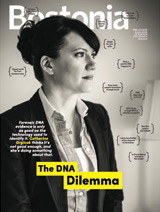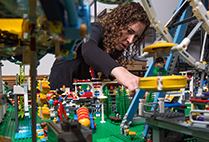When biomedical engineer Darren Roblyer set up his Biomedical Optical Technologies Lab (BOTLab) at BU after arriving in 2012, he immediately started cold-calling doctors. He told them about a device he’d made, a new way of imaging tumors that could help cancer patients. It’s worth your time, he told them.
“I knew I wanted to get my device into the clinic,” says Roblyer, a College of Engineering assistant professor of biomedical engineering.
That device allows doctors to peer through the skin into breast cancer tumors and see their response to chemotherapy. Its readouts are instantaneous, and preliminary studies offer hope that the technology may someday provide doctors with information that currently eludes them: an immediate alert when drugs aren’t working.
“It’s a window into the tumor. You can actually see what’s going on biologically without taking a biopsy,” says Catherine Klapperich, an ENG professor of biomedical engineering and of mechanical engineering and associate dean for research and technology development.
Breast cancer is typically diagnosed with a biopsy after an abnormal mammogram; doctors rarely do additional imaging or biopsies to track progress. Rather, they prescribe a treatment plan, and for the most part, stick with it. The plan varies depending on the genetic makeup of the tumor, the tissue structure, and the size. For some women, particularly those with large tumors that would be difficult to remove without taking the entire breast, doctors prescribe medicine to shrink the tumor first.
The medicine typically includes chemotherapy, which has a range of debilitating side effects. But most women respond extremely well to this therapy—five years later, 75 to 90 percent are cancer-free, according to Naomi Ko, a School of Medicine assistant professor of hematology and medical oncology and a breast oncologist at Boston Medical Center (BMC).
It’s the remaining 10 to 25 percent Roblyer hopes his device will help. These women don’t respond to the chemotherapy and spend months suffering its side effects without any benefit. Currently, says Ko, the best tool she has to determine if a patient is responding is to feel the tumor with her fingers and get a rough measure of its size using a ruler. “What you don’t want is the tumor to grow, meaning the chemo is not working,” she says. “That happens. I’ve had to send a patient emergently to the operating room for surgery.”
Read the full story on BU Today














































Related Stories
Breast Cancer Beacon
ENG researchers’ new device could make lumpectomies faster, more precise
Dioxins Point to Targets for Treating Breast Cancer
SPH’s David Sherr follows toxins’ trail to understand aggressive cancers
Zebrafish Cancer Genetics Illuminate Human Breast Cancers
MED’s Hui Feng focuses on MYC gene
Post Your Comment